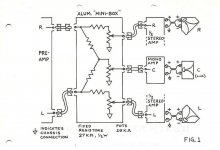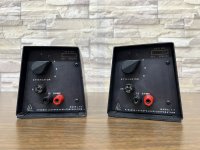Hi all! While not quite as diy as other projects I’ve worked on I’m hoping the great folks here can help out.
I have a pair of 1980s klipschorns with the ak2 crossovers. My room isn’t quite ideal and has around 20’ between the two which leaves a less than ideal stage. I’m hoping to add a pair of t1 ribbon tweeters from sequerra/pyramid to aim into the listening position and help fill the hole a bit.
My question is I’m not 100% sure where the best place to wire the new tweeter in would be.
Thoughts:
I can tap into the full signal out of my amp, or the HF taps on the bass bins( leaving the existing tweeter connected) , or removing the existing tweet and going to the ribbon instead.
Unsure how this would impact the impedance and I’m a bit reluctant to tear apart the k horns to experiment if I don’t have to. I have DATS and a calibrated mic to check thinks over once done.
Thanks for the input!
I have a pair of 1980s klipschorns with the ak2 crossovers. My room isn’t quite ideal and has around 20’ between the two which leaves a less than ideal stage. I’m hoping to add a pair of t1 ribbon tweeters from sequerra/pyramid to aim into the listening position and help fill the hole a bit.
My question is I’m not 100% sure where the best place to wire the new tweeter in would be.
Thoughts:
I can tap into the full signal out of my amp, or the HF taps on the bass bins( leaving the existing tweeter connected) , or removing the existing tweet and going to the ribbon instead.
Unsure how this would impact the impedance and I’m a bit reluctant to tear apart the k horns to experiment if I don’t have to. I have DATS and a calibrated mic to check thinks over once done.
Thanks for the input!
Appreciate the suggestions, but for number of reasons I can’t use a third speaker like Paul klipsch sugggested using his black box.
I’m really interested in the t1 as I have a pair and know they sounded great when I heard them in a friends system.
I’m really interested in the t1 as I have a pair and know they sounded great when I heard them in a friends system.
It's always possible to filter from the full range signal while presenting a high impedance to low frequencies. I'm not familiar with the crossovers you mention, but what are your concerns, or what do you want to achieve doing it a particular way?
Hi AllenB thank you for the question. My question is what is the best way to hookup the Pyramid T1 to an existing loudspeaker (like the k horn). unfortunately i can't find any documentation on it.
thx Glyph! do you have a link for that interweb content? I wasn't able to find anything remotely helpful like this.
I see you were concerned about the response crossing to the other tweeter.. the other side to this is the impedance. Broadly speaking an application like this wouldn't cause too much concern but you should probably at least look at the nominal impedances of each tweeter.
- Home
- Loudspeakers
- Multi-Way
- Adding Sequerra T1 to AK-2 Klipschorn?

